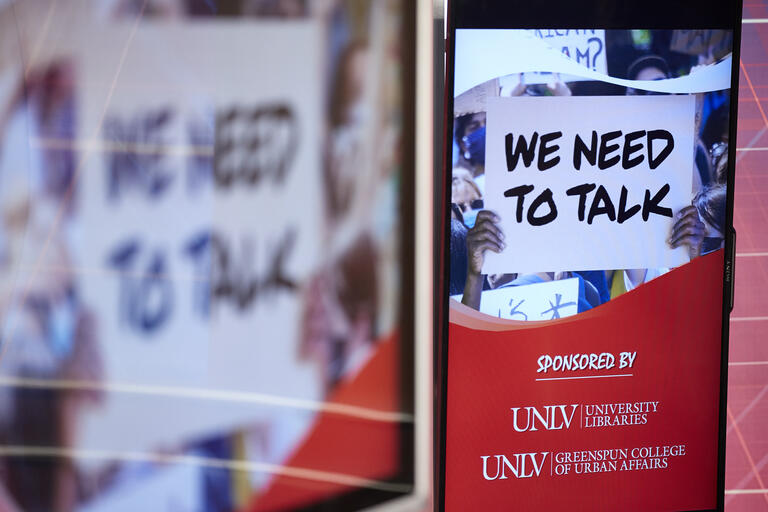Living beneath bridges, sleeping hidden atop school bleachers, and moving from couch to couch at friends' residences, homeless youths constitute a growing demographic nationally, and their circumstances are contributing to what UNLV professors have called a tragic crisis in Southern Nevada.
The first Southern Nevada Youth Homelessness Summit at the Venetian on Nov. 2 allowed experts from multiple disciplines to come together to address the issue of the deepening youth homelessness crisis, creating a blueprint for steps Southern Nevada can take to fight it.
The event, which was a step toward the formation of a plan to be presented at next year's conference, is just a portion of the new movement to end youth homelessness locally as a collaboration between the UNLV Greenspun College of Urban Affairs, the Nevada Partnership for Homeless Youth (NPHY), Sands Cares — the corporate giving program of Las Vegas Sands Corp., and the Las Vegas Review-Journal.
"The Greenspun College of Urban Affairs’ mission is to develop innovative solutions to urban problems," said Dean Robert Ulmer, who recruited faculty and staff within the college to aid in the effort. "We are excited to partner with Las Vegas Sands and NPHY to develop creative and collaborative solutions to eradicate youth homelessness in Southern Nevada. We understand that no one group or organization can solve this problem alone."
College of Urban Affairs faculty and staff were among the attendees and presenters at the conference, which provided participants ranging from teachers to real estate experts the chance to discuss local resources, funding strategies, and collaborations that could combat the rising trend in regional youth homelessness. Student volunteers from the School of Social Work, the School of Public Policy and Leadership, and the department of communication studies helped facilitate summit activities.
Seeking Long-Term Solutions
The term "crisis" is a common descriptor of the uphill battle facing local governments and outreach organizations nationwide as they attempt to find long-term, stable housing for youth without permanent shelter. The word is echoed in a first-of-its-kind research brief on Southern Nevada youth homelessness crafted by a group of Urban Affairs faculty and staff members.
The white paper, "The State of Homelessness in Southern Nevada," underscores the severity of the problem in the Silver State and allows a unique overall assessment of Nevada's fight: The state ranks first in the rate of unsheltered unaccompanied youth nationwide and fourth in the total number of unaccompanied homeless youth. Federal officials say more than 1,600 unaccompanied youth were counted in Nevada in 2016. Those youths face a number of risks from food and housing insecurity to physical threats on the street. Homeless youth who are undocumented residents of the country, identify as LGBTQ, or have been victims of sex trafficking are at even greater risk.
Among the needed steps to get the youths into permanent homes are tearing down barriers to information sharing and catching homeless youths before they fall through the cracks, according to local experts. Information silos prevent collaboration between agencies that could work together to identify and house homeless youth.

"How much easier could that fight be if we work together? That's what is necessary," said Jennifer Guthrie, assistant professor in the department of communication studies and a co-author of the research paper. "We know coordinated community responses have worked to address other issues, and this is how they start."
The conference attendees mentioned the importance of collaborations to cut down on costs, provide youths with housing options that meet their needs, address health or other issues, and improve coordination.
Overwhelming Need
Patricia Cook-Craig, a paper co-author and associate professor in the School of Public Policy and Leadership, previously has done research related to social support networks of homeless families.

"The need is overwhelming the resources. In order for change to be meaningful, it has to be well planned," she said, "That's a job in and of itself. We talk about homeless youth as if they are a uniform group, but they're not."
Cook-Craig emphasized that increasing cooperation between local agencies and outreach groups helps to ensure homeless youth are aware of resources, particularly if they are transient. It also aids government and law enforcement in identifying homeless individuals and putting them in touch with support networks, and it provides a way for agencies to share program ideas as well as physical items like spare clothes or food to cut down on costs.
Those are ideas she and her Urban Affairs colleagues hope to explore further as they search for solution-driven ways to address the issue.
"I don't know how to organize my academic life without knowing that I'm making a difference," Cook-Craig said. "Everything I do is guided by that. Being in a college that understands that, having a dean who supports that, is very fulfilling."
About the Report
“The State of Homelessness in Southern Nevada,” a report presented at the summit is available online and was co-authored by:
- Patricia Cook-Craig, associate professor in the School of Public Policy and Leadership
- Jennifer Guthrie, assistant professor in the department of communication studies
- William Sousa, associate professor in the department of criminal justice
- Carlton Craig, director of the School of Social Work
- Michael Bruner, chair of the department of communication studies
- Judy Tudor; child welfare training specialist in the School of Social Work
- Jessica Word, associate professor in the School of Public Policy and Leadership
- Melissa Jacobowitz, a graduate of the public administration program in the School of Public Policy and Leadership



